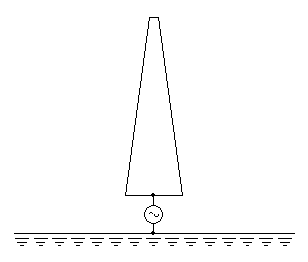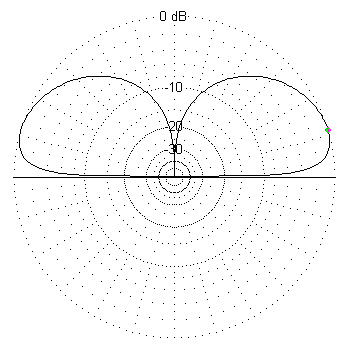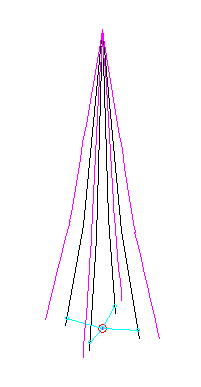
In order to get a rough idea of the performance of such antenna, it has been simulated and the gain, the radiation pattern, the antenna impedance and the current distribution has been calculated. Precise data about the structure are not available and the dimensions have been estimated via observation on site. No antenna performance data is available and therefore the result of the simulation cannot be checked against the reality and may be considerably wrong, but the figures look plausible and are reported and commented below.
The spare antenna of the Beromünster transmitter is a self supporting tower 126 m high. Its base is insulated from ground and connected to the feeder via a matching network. Transmission frequency is 531 kHz, one wavelength is 565 m and a quarter wavelength is 141 m.

Ground conductivity has a very big influence on the gain (the higher the conductivity the higher the gain), the elevation angle (the higher the conductivity the lower the angle) and the impedance. Unfortunately no information about ground conductivity is available. A value of 7.5 mS/m has been arbitrary chosen.
The simulation shows a gain of 1.1 dBd (including losses), which is not as good as the 1.9 dBd of the main antenna, but is still fair. The elevation angle is 17° and a half power beam-width of 44°. A very low radiation angle is important for long distance broadcast, since this antenna is smaller than the main antenna, only 17° can be achieved (compared to the 12° of the main antenna). As with all short antennas, the radiation pattern shows no side lobes, meaning reduced fading in the reception. Still this antenna radiates more energy toward the sky making it less performing against fading as the main antenna.

The current distribution on the mast is the typical one of short antennas (shorter than λ/4). The maximum current is 155 A at the feed point. The feed impedance is (21 – j48) Ω, meaning that for a power of 500 kW, the feed current is about 155 A and the feed voltage is 8.1 kV. To have a comparison, 500 kW on a 50Ω resistive load require a voltage of 5 kV and a current of 100 A.
